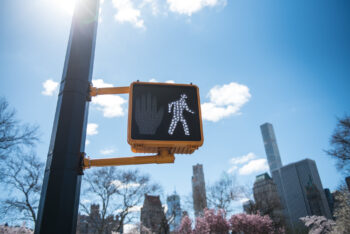
Image Credit: Michael Appleton/Mayoral Photography Office.
On February 15, 2024, the Department of Transportation celebrated the ten-year anniversary of the Vision Zero safety program, the City’s ongoing efforts to reduce and prevent deaths and serious injuries from traffic accidents and crashes. New York City was the first American city to develop a Vision Zero program. In over a century of recorded data, 2023 was the second safest year for pedestrians in New York City, and eight of the top ten safest years have occurred since the launch of Vision Zero.
Mayor Eric Adams stated, “Traffic safety is public safety, and pedestrians, cyclists, delivery workers, drivers, and everyone else using our roadways deserve safe streets. As we reach 10 years of Vision Zero in New York City, I want to commend DOT, and its partner agencies, for their unwavering commitment to the critical mission of protecting our fellow New Yorkers.”
Since the program’s launch in 2014, overall traffic deaths have declined by over 12 percent, with pedestrian deaths dropping by 45 percent. Some Vision Zero initiatives included: the reduction of the citywide speed limit from 30 miles per hour to 25 miles per hour; the installation of over 2,000 speed cameras which resulted in a 70 percent decrease in speeding in areas with cameras.
Other Vision Zero improvements focused on infrastructure changes to streets and intersections to make crossings safer for pedestrians including raised crosswalks, leading pedestrian intervals, pedestrian islands, wider sidewalks, pedestrian plazas and curb extensions. The creation of over 200 miles of protected bike lanes encourage New Yorkers to switch to bicycles or other alternative modes of transportation over vehicles. The agency found that protected bike lanes reduced pedestrian deaths and serious injuries by 29 percent, and deaths and serious injuries for seniors by 39 percent.
Vision Zero initiatives include education and outreach programs through a multi-agency approach to engage with New Yorkers in high-crash corridors. Transportation has made over 5,700 visits to schools and held over 1,400 workshops at senior centers, worked with over 158,000 licensed TLC drivers, and over 52,000 MTA bus operators have been trained with Vision Zero ideas. Over 90,000 city agency drivers have taken defensive driving courses. Multiple city agencies have worked with large truck drivers, commercial waste vehicle operators, and fleet managers to promote safety training and provide blind spot awareness programs. Other education programs include the Dangerous Vehicle Abatement Program, where owners of vehicles with 15 or more speed camera violations or five or more red light camera violations must complete a safe vehicle operation course or face the seizure and impoundment of their cars.
For more information about various Vision Zero initiatives and programs, click here.
Deputy Mayor for Operations Meera Joshi stated, “Ten years of Vision Zero is a bittersweet milestone as we cannot accept even one death due to preventable traffic violence on our streets. But it is indisputable that New York City is a better and more equitable city for the existence of this program and the tireless work of all of our city agencies and advocates to make New York streets safer for everyone.”
Transportation Commissioner Ydanis Rodriguez stated, “Through Vision Zero, we’ve saved lives and made our streets safer for everyone. We’re dedicated to ensuring all New Yorker’s reap the benefits of these initiatives. That’s why under the Adams Administration, we have expanded Vision Zero’s commitment to equity. We prioritize underserved communities when locating projects and have completed more projects in these communities than anywhere else.”
By: Veronica Rose (Veronica is the Editor of CityLand and a New York Law School graduate, Class of 2018.)

